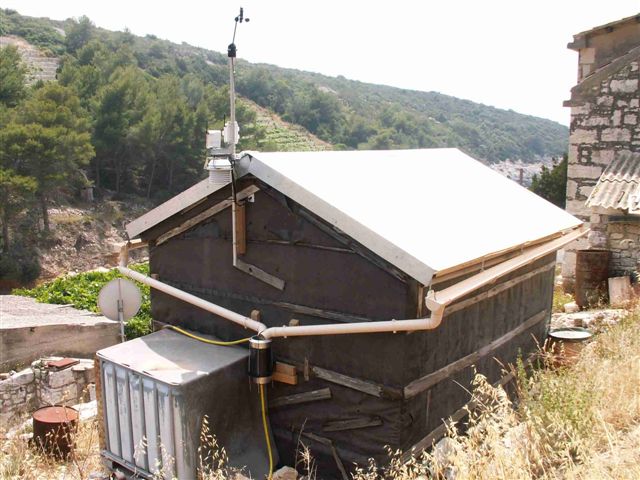Difference between revisions of "वाटर पोर्टल / वर्षाजल संचयन / कोहरा और ओस संग्रह / ओस बूंदों का संग्रह और भंडारण"
| Line 38: | Line 38: | ||
|} | |} | ||
| − | === | + | ===पर्यावरण में बदलाव के हिसाब से लचीला=== |
| − | + | यह सूखे अथवा अन्य बदलावों से प्रभावित नहीं होता. हां अगर आर्दता में कमी आती है तभी इस पर असर पड़ता है. आर्दता जितनी कम होगी, ओस भी उतनी ही कम बनेगी. | |
===Construction, operation and maintenance=== | ===Construction, operation and maintenance=== | ||
Revision as of 19:13, 29 November 2015
| |
|
|
|
|
|
|
|
|

ओस बूंदों का संग्रह हमें पेयजल उपलब्ध कर सकता है. ऐसे वक्त में जब भूजल, बारिश, कोहरा आदि कोई माध्यम उपयोगी न साबित हो रहा हो तब ओस संग्रहण महत्त्वपूर्ण मात्रा में पानी उपलब्ध करा सकता है. रात के समय ओस एकत्रित करने के लिए भूजल संरक्षण मॉडल भी इस्तेमाल किया जा सकता है. यह किसी सतह पर स्थित होता है जहां से पानी की बूंदें एक नाली नुमा निर्माण के सहारे जलाशय में चली जाती हैं. ओस से एकत्रित होने वाले पानी की मात्रा जगह के हिसाब से बदलती रहती है लेकिन कई बार यह सामान्य बारिश की तुलना मे काफी महत्वपूर्ण भी होता है. ओस का संग्रह शुष्क और अद्र्ध शुष्क इलाकों में पानी का संभावित पूरक है. लेकिन इसे लेकर अभी तक कोई बहुत बड़ा शोध नहीं हुआ है.
उपयुक्त परिस्थितियां
- बड़े पैमाने पर ऐसी भूमि जिसका इस्तेमाल न किया गया हो.
- सुबह से शाम तक समान तापमान (कम से कम 12 डिग्री सेल्सियस)
- धीमी हवा वाली जगह क्योंकि तेज हवा से ओस उड़ती है. हवा अगर चार मीटर से 10 मीटर प्रति सेकंड के दायरे में रहे तो बेहतर.
- जिन स्थानों पर ओस निर्माण तेज गति से होता है वहां हवा की गति 1-2 मीटर प्रति सेकंड तक नापी गई है.
- जब बादल छंट जाते हैं तब ओस ज्यादा तेजी से बनती है क्योंकि उस दौरान शीतलता बढ़ती है.
- सबसे अधिक ओस तब बनती है जब आर्दता बहुत अधिक हो और शीतलता कम.
- संघनीकरण करने वाला पदार्थ पर्याप्त होना चाहिए. वह ढलान पर स्थित हो और जल प्रतिरोधक हो.
इन परिस्थितियों में ओस का संग्रहण न करें:
- जहरीले पौधों पर या उनके करीब.
- रासायनिक उपचार या छिडक़ाव वाले पौधों या वस्तुओं पर
- उन क्षेत्रों में जहां आमतौर पर पशु मलत्याग करते हों.
- सडक़ के किनारे
| लाभ | हानि |
|---|---|
| - जल की गुणवत्ता अच्छी हो सकती है. - सूखे का कोई असर नहीं होता. |
- -इस प्रक्रिया से अपेक्षाकृत कम पानी संरक्षित किया जा सकता है. - जल संग्रह में अंतर. |
पर्यावरण में बदलाव के हिसाब से लचीला
यह सूखे अथवा अन्य बदलावों से प्रभावित नहीं होता. हां अगर आर्दता में कमी आती है तभी इस पर असर पड़ता है. आर्दता जितनी कम होगी, ओस भी उतनी ही कम बनेगी.
Construction, operation and maintenance
The best time to gather dew is in the early morning before the sun has touched your collection area.
The catchment area needs to be large enough to collect the required amount of water, while also being practical to where it is collected. Typical collection rates vary according to the site – in Morocco rates of collection were 18.9 litres/m2/yr (in an area of 215mm annual rainfall) whereas in Spain rates increased to a range of 41.5 to 71.1 litres/ m2/yr (in an area of between 246 – 324mm annual rainfall).
Efficiency of collection: it seems that elevated surfaces collect 14% more water compared to one on the ground. It may also be helpful to use galvanized roof sheets that can be painted with special OPUR paint – this paint enhances infrared cooling and remain hydrophilic due to photocatalytic reaction with ultraviolet light. Such a system was created in Morocco where painted sheets were underlain with a 2cm thick polystyrene insulation, and the roof pitch was 30 degrees. The system uses radiative cooling at night. Foil can also be used but is prone to damage.
Dew collection can also be used to create a form of micro irrigation where plastic trays are used to funnel dew to plant roots.
Costs
Costs vary widely, but the materials needed in each locality will determine total costs to build a system.
A simple system consists of a large flat angled surface, pipes or gutters to transport the dripping, and a collection tank.
Field experiences
Manuals, videos, and links
International Organization for Dew Utilization (OPUR)
Acknowledgements
- CARE Nederland, Desk Study: Resilient WASH systems in drought-prone areas. October 2010.
- M. Mileta, D., Beysens and V. Nikolayev, et al. Fog and Dew Collection Projects in Croatia Croatia and France, 2004.
- Dew Collection for Survival Water Tactical Intelligence. July 2011.

